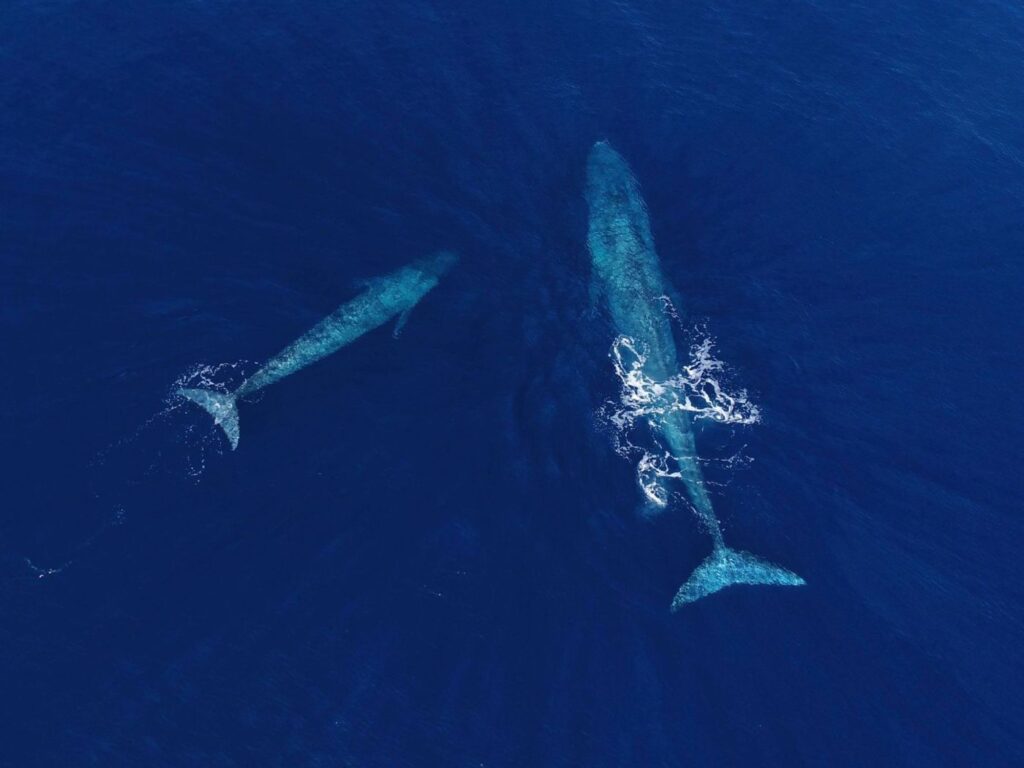
The behemoth blues are back – and they’ve brought some babies as they hang out along the coast.
Blue whales, the world’s largest animal, have been spotted off the Southern California coastline in recent days, showing up with calves frolicking alongside as they forage for food.
There were sightings of the massive blue whale Friday, June 17, and Saturday off Catalina Island, and then two sets of moms and calves were seen on Sunday about six miles off the coast. Another mom-calf duo were spotted on Tuesday about nine miles off Laguna Beach.
“When you think that the blue whale is the largest animal to live on the planet – bigger than a dinosaur or a megalodon – that is amazing,” said Nona Reimer, a naturalist for Dana Wharf Sportfishing & Whale Watching. She was actually talking on her cellphone from an ocean tour that was watching the whales on Tuesday, cheers in the backdrop coming from the excited spectators on the boat.
The sleek-bodied blue whale can reach up to 100 feet long and feed on 2 tons to 4 tons of krill a day.
Newport Coastal Adventure Capt. Ryan Lawler said there’s been reports from San Diego about their presence for the past month.
“Although it’s not really a migration, they start feeding in the south. We know they’ll eventually filter up,” he said of the whales that will follow the krill, pushed by the current moving from south to north. “We’ve been waiting a solid month wondering, ‘When are the blue whales finally going to make it to Orange County?’”
Over the weekend, he took all-day excursions out near Catalina Island to see the blue whales hanging around and feeding. Then on Sunday, he was tipped off about a pod of five or six whales about halfway between the island and mainland.
“That action lasted for a day or so, we lost them and again today they are back closer to the coastline,” Lawler said on Tuesday.
The presence of the calves adds an extra element of excitement.
“The babies are so curious. We really love to see the babies. Some years we don’t see any babies,” he said. “The other day, we all got to see one playing around.”
While adult blue whales are typically focused on feeding, diving deep for long periods to scoop up krill, the babies stay near the surface and wait for their mom’s return, at times curiously drawn to the boats. One of Lawler’s boat captains was able to get underwater footage as a whale sauntered under their boat.
Stacie Fox, a photographer with Capt Dave’s Dana Point Dolphin & Whale Watching Safari, snapped photos of a calf playing and twirling in the water, with the mother whale nearby keeping a close watch on her “spirited calf.”
“Seeing a blue whale is always exciting,” Fox said in a news release.
Blue whales, the world’s largest animal, are hanging out off the Orange County coastline and Catalina Island recently, bringing excitement on the water as they feed off local waters. (Photo courtesy of Mark Girardeau/Newport Coastal Adventure)
“Seeing a baby blue whale is extra exciting,” she added, calling the chance to watch one play, “one of the most incredible experiences of my life. The whale was so interactive and would do circles around and under the boat, checking us out as much as we were checking it out.”
Thanks to regulations in recent decades better protecting the whales that had been hunted to near extinction, their numbers have been rebounding, experts say. An estimated 20,000 swim oceans world-wide and 2,000 or so come to feed off the coast of California during summer months, Reimer said.
“These guys have made a miraculous comeback,” she said.
It is unknown how long the blue whales will be sticking around. It all depends on how much food they can forage off the coast.
Prior to the mid-2000s, whale watchers would have to typically trek up to the Channel Islands or off Monterey to get a glimpse of the sleek-bodied blue whales after they had spent the winter months off Costa Rica and Mexico. In the late ’90s, there were some years with only a dozen or so sightings off Southern California.
But then, the numbers seen locally surged, prompting a wave of whale-watching businesses to open or expand their operations to year-round.
Related Articles
Gray whale is swimming free after rescuers cut loose massive bundle of netting
Navy says more precautions for whales in place, but asks NOAA for changes to training permits
In 2008, Dana Wharf’s whale watching logs recorded about 130 blue whales spotted, then 291 the following year. In 2011, there was a surge of blue whales and they were seen nearly every day during the summer – a total of 752 sightings were logged that season. Water conditions changed, however, when an El Nino showed up.
The food disappeared, and so did the whales. According to Dana Wharf logs, sightings dropped from a little more than 400 in 2014, to about 100 in 2016.
In 2017, there were only about 40 blue whale sightings logged, with a bit of a rebound in 2018, but still lower than previous years. In the past few years, there’s been sporadic sightings through the summer, but nowhere near the numbers a decade ago.
Figures in 2020 were hard to track because trips were canceled during the pandemic. Last summer, there were about 40 sightings recorded by Dana Wharf. So far this month, Dana Wharf has logged about a dozen sightings, hinting –hopefully – at a strong summer season of blues.
“It remains to be seen,” Lawler said, “how long this can last.”
